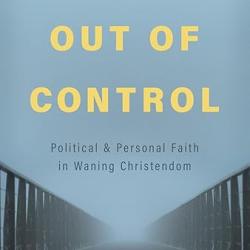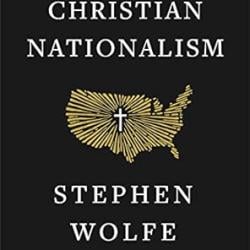Yesterday I received in the mail a copy of the cover of a book to be published by Zondervan later this year: Four Views on the Spectrum of Evangelicalism edited by Andrew David Naselli and Collin Hansen. It’s a volume in the Zondervan series Counterpoints whose general editor is Stanley N. Gundry. The four authors are: Kevin Bauder (Fundamentalism), Al Mohler (Confessional Evangelicalism), John Stackhouse (Generic Evangelicalism) and Roger Olson (Postconservative Evangelicalism). Each author responds to the other three. The exact date of publication is uncertain, but it will probably be in September or October.
While I found it useful and even enjoyable to be part of this discussion, I am increasingly uncomfortable with attempts to pin down and define evangelicalism. It is undeniably an essentially contested concept. So what you will get in this book (as in others like it) are four personal interpretations of evangelicalism. None of us is the pope of evangelicalism. None of us has a patent on it. There is no magisterium to appeal to. It’s unclear what exactly we’re all talking about. Are we even talking about the same thing? Is there a “thing” to talk about? Are we reifying something that is essentially elusive?
Some people use the term “evangelicalism” to name a very broad movement of relatively conservative, mostly pietistic Protestants influenced to some extent by American revivalism beginning with the Great Awakening of the 1740s. Others, and sometimes the same people, use the term to name a very specific movement out of fundamentalism led originally by Harold John Ockenga and his friends such as Carl F. H. Henry.
These are just two of the many meanings of “evangelicalism.” (If we widen the discussion to be also about the word “evangelical” it gets more interesting and confusing. Lutherans call themselves evangelical and in Europe it simply means Protestant.) Here I am limiting my comments to “evangelicalism” to avoid getting into that much broader and more difficult discussion about “evangelical.”
When I talk, as a historical theologian who self-identifies as evangelical, about “evangelicalism” I need to make clear which of the above two meanings I have in mind. I probably don’t always take the time to do that. People who listen in on this conversation need to realize and understand these two related but distinct meanings of evangelicalism.
Evangelicalism defined as a certain type of relatively conservative Protestant Christianity deeply marked by Pietism, Puritanism and Revivalism and stemming from the Great Awakening of the 1740s includes fundamentalism. But it also includes some folks very far from fundamentalism. (Kevin Bauder, a professor at Central Baptist Theological Seminary in Minneapolis helpfully defines real fundamentalism for us in the forthcoming book.) In fact, this “evangelicalism” can hardly be said to be a movement at all. It may have been at one time, but like most movements that “catch on” it has simply filtered into the fabric of American society and other societies and cultures around the world.
It seems futile to try to define or pin down or draw any sort of boundaries around that first kind of evangelicalism. It has some historical features such as the four identified by historians Mark Noll and David Bebbington: biblicism, conversionism, crucicentrism and activism. But different wings and branches of it emphasize those differently. It includes all kinds of relatively conservative, somewhat revivalistic or at least pietistic Protestant Christians and, because of the charismatic movement, even some Roman Catholics. This is the evangelicalism so beautifully portrayed by my friend Randall Balmer in his book and video series Mine Eyes Have Seen the Glory: A Journey into the Evangelical Subculture in America. It includes most African-American churches, most, if not all, “seeker sensitive” megachurches, most Pentecostals, all of the Holiness churches, etc., etc.
The other evangelicalism is a little less ambiguous. And, until recently, it did not include fundamentalism. In fact, when it began in the 1940s fundamentalists labeled it “neo-evangelicalism” to distinguish it from them. I call it “postfundamentalist evangelicalism.” It was born in 1942 with the founding of the National Association of Evangelicals. Fundamentalist leader Carl McIntire’s American Association of Christian Churches was invited to join but declined because of the presence of Pentecostals in the NAE. At that moment fundamentalists and evangelicals parted ways. The NAE and the Billy Graham empire of ministries then spawned and tried to oversee this burgeoning new movement that came to include about 50 denominations in the U.S. and thousands of independent churches and parachurch organizations.
Even this second type of evangelicalism is difficult to define and pin down. It has no magisterium. Most people affiliated with it look to Billy Graham as its figurehead. As Graham gradually leaves the scene, however, and as the NAE has experienced extreme difficulties, postfundamentalist evangelicalism has become increasingly amorphous and the subject of heated debate (e.g., about its boundaries).
ONE difference is that the first type of evangelicalism includes fundamentalists while the second does not. EXCEPT that in recent years some fundamentalists have infiltrated it and some conservative evangelicals in the movement have begun to act like fundamentalists. What started out as an attempt to move evangelicalism out of and beyond fundamentalism in 1942 has become an increasingly fundamentalist movement in terms of its loudest voices.
This twofold explanation of “evangelicalism” helpfully answers many questions often asked about evangelicalism. Are Southern Baptists evangelicals? In terms of the first meaning, yes. In terms of the second meaning, some are and some aren’t. The SBC never joined the NAE and has kept itself somewhat aloof from the postfundamentalist evangelical movement until recently when some of its loudest voices have attempted to move the SBC toward it while at the same time attempting to take it over theologically.
Are separatistic fundamentalists part of the evangelical movement. With regard to the first meaning of evangelicalism, yes. With regard to the second, no–not historically.
Does evangelicalism have boundaries? The first kind absolutely does not and cannot. It has always been too diffuse for that. The second kind has no definite boundaries but it does have leaders most people look to to give it some shape–Billy Graham being the most notable. Christianity Today, Inc. is often regarded as a kind of mouthpiece publication of the second kind of evangelicalism.
Are certain well known institutions part of evangelicalism? More are if you are talking about the first meaning of evangelicalism; fewer are if you are talking about the second. For example, the Christian College Consortium includes 13 Christian liberal arts colleges/universities that see themselves as representing the cream of the crop of mainstream postfundamentalist evangelicalism. This organization has always been closely associated fraternally (not organizationally) with the NAE. The Council for Christian Colleges and Universities (CCCU) (formerly the Coalition of Christian Colleges and Universities) is composed of over 100 Christian institutions of higher education many of which have never viewed themselves as any part of the postfundamentalist evangelical movement that started in 1942.
Can Roman Catholics be evangelical (in the sense of part of evangelicalism)? Some are part of the first evangelicalism–largely because of the charismatic movement. A few individual Catholics have participated in the second evangelicalism from time to time, but, generally speaking, it is a distinctly Protestant phenomenon.
Of course these two evangelicalisms overlap a great deal. In fact, the second one is probably rightly included wholly in the first one. The main difference is that the second, smaller and narrower one has historically not included separatistic fundamentalists while the first, broader and inclusive one has included fundamentalists and their precurors (before about 1900).
I urge that it is very important be clear about which evangelicalism one means when using that category label. The first is more of a religious and spiritual ethos than the second. The second is marked by that same ethos but has more definite historical shape. I argue that even the second has no definite boundaries because it is a movement and not an organization, but the Billy Graham empire of ministries, the NAE, and Christianity Today, Inc. (and previously Eternity magazine when it was published) TEND to define it.
Some of this information (if you can call it that and it might be better to call it insight or perspective) comes from books such as Joel Carpenter’s Revive Us Again and the writings of historians Mark Noll and George Marsden. Some of it comes from personal experience in evangelical organizations and institutions over 30 plus years (e.g., as editor of Christian Scholar’s Review). Some of it comes from being my uncle’s nephew; he served on the executive board of the NAE for many years. We had numerous, lengthy and detailed discussions about the meaning of evangelicalism.
I think keeping these two meanings of evangelicalism distinct (if not separate) would go far toward solving many of the debates and controversies about evangelicalism. Specifically, I propose from now on that everyone comments here about evangelicalism give some clue about which they mean.












